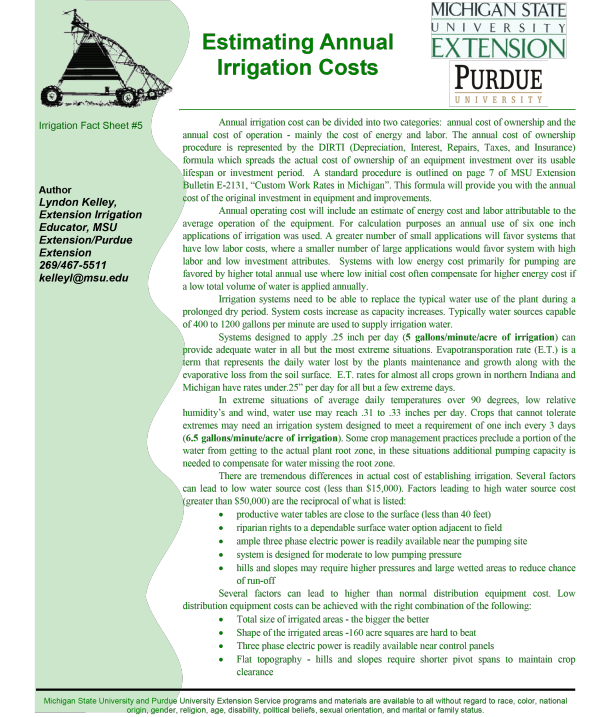
Bulletin Irrigation Fact Sheet #5
Estimating Annual Irrigation Costs
DOWNLOAD
Annual irrigation cost can be divided into two categories: annual cost of ownership and the annual cost of operation - mainly the cost of energy and labor. The annual cost of ownership procedure is represented by the DIRTI (Depreciation, Interest, Repairs, Taxes, and Insurance) formula which spreads the actual cost of ownership of an equipment investment over its usable lifespan or investment period. A standard procedure is outlined on page 7 of MSU Extension Bulletin E-2131, “Custom Work Rates in Michigan”. This formula will provide you with the annual cost of the original investment in equipment and improvements.
Annual operating cost will include an estimate of energy cost and labor attributable to the average operation of the equipment. For calculation purposes an annual use of six one inch applications of irrigation was used. A greater number of small applications will favor systems that have low labor costs, where a smaller number of large applications would favor system with high labor and low investment attributes. Systems with low energy cost primarily for pumping are favored by higher total annual use where low initial cost often compensate for higher energy cost if a low total volume of water is applied annually.
Irrigation systems need to be able to replace the typical water use of the plant during a prolonged dry period. System costs increase as capacity increases. Typically water sources capable of 400 to 1200 gallons per minute are used to supply irrigation water.
Systems designed to apply .25 inch per day (5 gallons/minute/acre of irrigation) can provide adequate water in all but the most extreme situations. Evapotransporation rate (E.T.) is a term that represents the daily water lost by the plants maintenance and growth along with the evaporative loss from the soil surface. E.T. rates for almost all crops grown in northern Indiana and Michigan have rates under.25” per day for all but a few extreme days.
In extreme situations of average daily temperatures over 90 degrees, low relative humidity’s and wind, water use may reach .31 to .33 inches per day. Crops that cannot tolerate extremes may need an irrigation system designed to meet a requirement of one inch every 3 days (6.5 gallons/minute/acre of irrigation). Some crop management practices preclude a portion of the water from getting to the actual plant root zone, in these situations additional pumping capacity is needed to compensate for water missing the root zone.
There are tremendous differences in actual cost of establishing irrigation. Several factors can lead to low water source cost (less than $15,000). Factors leading to high water source cost (greater than $50,000) are the reciprocal of what is listed:
- productive water tables are close to the surface (less than 40 feet)
- riparian rights to a dependable surface water option adjacent to field
- ample three phase electric power is readily available near the pumping site
- system is designed for moderate to low pumping pressure
- hills and slopes may require higher pressures and large wetted areas to reduce chance of run-off
Several factors can lead to higher than normal distribution equipment cost. Low distribution equipment costs can be achieved with the right combination of the following:
- Total size of irrigated areas - the bigger the better
- Shape of the irrigated areas -160 acre squares are hard to beat
- Three phase electric power is readily available near control panels
- Flat topography - hills and slopes require shorter pivot spans to maintain crop clearance



 Print
Print Email
Email



